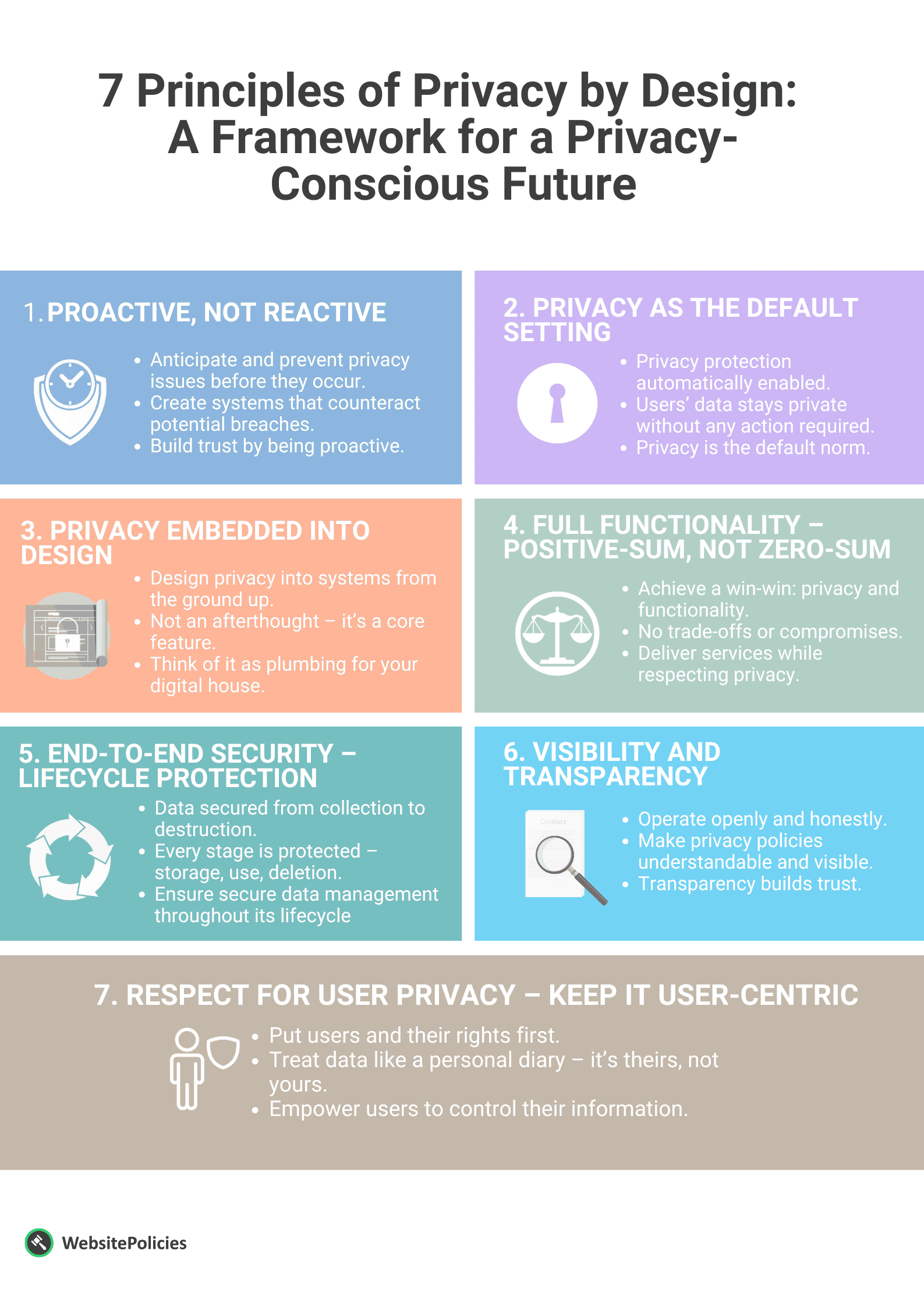In a data-driven digital era, safeguarding user information is paramount. Enter Privacy by Design, a groundbreaking concept that integrates privacy considerations from project inception.
This proactive approach builds trust, prevents breaches, and ensures user-centric privacy.
Let’s explore it along with the 7 Privacy by Design principles, their impact on major privacy laws, and the important distinction between privacy and security.
You’ll also learn how this innovative approach fortifies digital landscapes, creating a secure and privacy-conscious future.
- Privacy by Design advocates integrating privacy considerations from the outset of projects to prevent issues and build trust with users.
- The 7 Principles of Privacy by Design emphasize proactivity, default privacy settings, privacy integration, and user-centric respect.
- Privacy and security are related but distinct concepts. Privacy focuses on data use and management, while security protects data from threats.
Table of Contents
PRO TIP: Take the hassle of writing your own privacy policy away with our privacy policy generator trusted by over 200,000 businesses. It’ll save you hours of work and possible costly legal mistakes.
What is Privacy by Design?
Privacy by Design is a concept in data protection and privacy that advocates for including privacy considerations in the initial design stages of projects, rather than as an afterthought.
Now, let’s unpack that a bit more. Imagine you’re building a house. You wouldn’t just slap on a roof after you’ve built the walls, right? It’s the same with Privacy by Design.
It’s all about making sure that privacy is not an afterthought, but a key component right from the start of any project, system, or service you’re developing.
In the context of your online business, this means considering how you’ll protect your users’ data from the moment you start designing your website or app.
It’s about being proactive, not reactive. It’s about ensuring that privacy is baked into your business model, rather than being a sprinkling of icing sugar dusted on top at the end.
And why is this important? Well, aside from the fact that it’s a legal requirement in many jurisdictions, it also builds trust with your users.
PRO TIP: In the online world, trust is everything. So, think of Privacy by Design as your trusty foundation, the bedrock upon which you’re building your online empire. It’s not just good practice, it’s smart business.
7 Principles of Privacy by Design
Now, let’s turn our attention to the seven principles of Privacy by Design. These principles aren’t just theoretical – they provide a practical framework for integrating privacy into your online business.
Let’s look into these guiding principles and see how they can help shape a more privacy-conscious future for your business.

1. Proactive, Not Reactive
This principle is akin to having a crystal ball. It’s all about foreseeing and preventing privacy issues before they become a problem. It’s about anticipating potential issues and having measures in place to counteract them.
Instead of waiting for a privacy breach and then dealing with the fallout, you’re taking steps to prevent that breach from happening. It’s about creating systems and processes that are designed to prevent privacy invasions.
This approach not only saves you from potential legal issues down the line but also builds trust with your users.
2. Privacy as the Default Setting
This principle is about automatic protection. It’s about ensuring that personal data is automatically protected in any system or business practice. If an individual does nothing, their privacy still remains intact.
No action is required on the part of the individual—it’s built into the system, by default. It’s like having a guardian angel for your users’ data, always there to protect it.
This principle ensures that privacy is the norm, not the exception.
3. Privacy Embedded into Design
This principle is about making privacy an integral part of your system. It’s not tacked on as an afterthought or a nice-to-have feature. It’s a core function that’s integral to your system or practice.
It’s about designing your systems and practices with privacy in mind from the very beginning. It’s like building a house with the plumbing in mind, not trying to install pipes after the fact.
This approach ensures that privacy is an essential component of your product or service.
4. Full Functionality – Positive-Sum, not Zero-Sum
This principle is about achieving a win-win scenario. It’s about rejecting the idea that you have to sacrifice privacy for the sake of security, or vice versa.
You aim to provide full functionality – delivering all the required services while still maintaining user privacy. It’s about finding solutions that respect privacy while still providing the functionality that users expect.
It’s like having your cake and eating it too, and who doesn’t love cake?
5. End-to-End Security – Lifecycle Protection
This principle is about ensuring security from start to finish. From the moment data is first collected until its final destruction, it’s securely managed.
It’s about providing a secure travel path for your users’ data throughout its entire lifecycle. It’s about ensuring that every stage of your data processing – from collection to storage, use, and deletion – is secure.
This principle ensures that data is protected throughout its entire life cycle within your system.
6. Visibility and Transparency
This principle is about being open and honest. Your systems and practices are transparent, and you operate in a way that’s visible and understandable to users and providers alike.
It’s about making sure your users understand what happens to their data, how it’s used, and how it’s protected. It’s like opening your kitchen to your restaurant diners. They can see everything you’re doing, and that builds trust.
Transparency is key to building and maintaining trust with your users.
7. Respect for User Privacy – Keep it User-Centric
This principle is about putting the user first. Users have rights to their own data, and these rights are respected and preserved by you.
It’s about treating your users’ data like a personal diary. It’s theirs, not yours, and you need to respect that. It’s about ensuring that users maintain control over their personal information.
This principle ensures that respect for user privacy is at the forefront of your business.
Are Privacy and Security the Same Thing?
Privacy and security are not the same thing even though they are closely related.
Privacy is about how that data is used, shared, and managed. It’s about respecting and protecting user rights regarding their personal information and should be clearly explained in your privacy policy.
It’s also about ensuring that the data you collect is used in a way that respects the rights and expectations of the individuals it pertains to. It’s like the rules that govern who you let into your fortress and what they can do once they’re inside.
Security, on the other hand, is about protecting data from unauthorized access. It involves implementing measures like firewalls, encryption, and strong passwords to safeguard data from potential threats.
It’s about building a robust defense system to protect your data from cyberattacks, much like a fortress that guards against invaders.
In essence, privacy is concerned with the policies and procedures that govern how that data is used and shared, while security focuses on the measures used to protect data.
Both are important in the digital world and one does not replace the need for the other. They work together to ensure that data is not only safe from threats but also handled with respect for the individual’s rights.
ALSO READ: A Definitive Guide to Privacy Policies
How Does Privacy by Design Affect Privacy Laws?
Privacy by Design is a concept that has been embraced by many privacy laws and regulations around the world, even if they don’t explicitly use the term.
The principles of Privacy by Design are universal and can be applied to virtually any legislation that deals with personal data.
Privacy by Design in the GDPR
The General Data Protection Regulation (GDPR) is a game-changer in the world of data protection, and Privacy by Design plays a starring role in this regulation.
Under the GDPR, Privacy by Design is no longer just a good practice, it’s a legal requirement. Article 25 of the GDPR is dedicated to “Data protection by design and by default”.
It mandates that organizations must implement appropriate technical and organizational measures to ensure that data protection principles are baked into their processing activities.
This means that right from the start of designing a new system, product, or process, privacy must be one of the core considerations.
It’s about minimizing personal data use, processing, and retention of what’s necessary for the task at hand. It’s about integrating privacy into the very fabric of your operations.
The GDPR also emphasizes the need for “privacy as the default setting”. This means that without any action from the user, the privacy settings must be set at the highest level.
It’s about ensuring that personal data is automatically protected without any manual input from the user. Failure to comply with these requirements can lead to hefty fines under the GDPR.
Privacy by Design isn’t just a smart strategy – it’s a critical compliance requirement for businesses operating in or serving customers in the European Union.
It’s like the secret ingredient in your GDPR compliance recipe. Without it, you’re missing an essential component.
Privacy by Design in the CCPA
The California Consumer Privacy Act (CCPA) is another significant piece of legislation in the realm of data protection, and while it doesn’t explicitly mention Privacy by Design, the principles are woven throughout the law.
The CCPA gives California residents more control over their personal information, including the right to know what data is being collected, the right to delete personal information held by businesses, and the right to opt out of the sale of personal information.
These rights align closely with the principles of Privacy by Design, particularly the principles of “Respect for User Privacy” and “Visibility and Transparency”.
The CCPA doesn’t explicitly require Privacy by Design but implementing these principles can help businesses comply with the law.
For instance, being proactive and embedding privacy into the design of your systems can help ensure that you’re ready to respond to consumer requests about their data.
Similarly, having privacy as the default can help ensure that you’re only collecting and sharing data in a way that respects the rights of consumers.
PRO TIP: While Privacy by Design might not be a specific requirement of the CCPA, it’s a strategy that can help businesses meet their obligations under the law. It’s like having a compass that guides you through the complex landscape of CCPA compliance.
Privacy by Design in the LGPD
The LGPD is Brazil’s answer to the global call for enhanced data protection regulations. Much like its international counterparts GDPR and CCPA, the LGPD emphasizes the importance of privacy, and the principles of Privacy by Design are implicitly present throughout the legislation.
While the LGPD does not explicitly mention Privacy by Design, the law’s tenets echo the principles. The LGPD outlines nine principles for processing personal data, including transparency, security, and prevention, which align closely with the principles of Privacy by Design.
For instance, the LGPD’s emphasis on prevention, which is about adopting measures to prevent the occurrence of harm due to the processing of personal data, mirrors the proactive, not reactive principle of Privacy by Design.
Similarly, the LGPD’s requirement for transparency, ensuring clear, precise, and easily accessible information about the processing of personal data, aligns with the visibility and transparency principle.
PRO TIP: Implementing Privacy by Design can therefore help organizations comply with the LGPD. By embedding privacy into the design of systems and processes, businesses can ensure they are meeting the LGPD’s requirements for data processing.
Privacy by Design in Other Laws
So, while the term “Privacy by Design” might not appear in every privacy law, the philosophy behind it is a common thread. It’s like a universal language in the world of data protection.
No matter where you are or what specific law you’re dealing with, the principles of Privacy by Design can guide you toward better privacy practices.
In Australia, the Privacy Act and the Australian Privacy Principles (APPs) also reflect elements of Privacy by Design. The APPs outline obligations for organizations, including the need for transparent management of personal information and robust security safeguards.
In Asia, countries like Singapore and Japan have data protection laws that, while not explicitly mentioning Privacy by Design, embody its principles.
The Personal Data Protection Act (PDPA) in Singapore and the Act on the Protection of Personal Information (APPI) in Japan both emphasize the importance of data minimization, purpose limitation, and security—core elements of Privacy by Design.
Privacy by Design Examples
Let’s bring the principles of Privacy by Design to life with some real-world examples. These scenarios illustrate how these principles can be practically applied across different industries and contexts.
Social Media Platform
A social media platform could implement Privacy by Design by setting user profiles to the highest privacy settings by default.
This means that when a user creates a new account, their posts, photos, and profile information are only visible to them or their approved friends unless they choose to change these settings.
E-commerce Site
An e-commerce site could embody the principle of “Privacy Embedded into Design” by ensuring that customer data is encrypted both at rest and in transit.
This means that even if a data breach occurs, the stolen data would be useless to the thieves because it’s encrypted.
Email Marketing
An email marketing platform could show “Respect for User Privacy” by using an opt-in approach vs opt-out and implementing a clear and easy-to-use unsubscribe mechanism in all emails. This respects the user’s right to withdraw their consent at any time.
Online Survey
An online survey could demonstrate “Privacy as the Default Setting” by anonymizing responses by default.
This means that unless the user chooses to provide their name or email address, their responses are not linked to their identity.
10 Steps to Apply Privacy by Design to an Existing Website
Applying Privacy by Design to an existing website can be a bit difficult (think retrofitting a house), but it’s certainly doable and worthwhile. Here are some steps you can take:
- Conduct a Privacy Audit: The first step is to understand what personal data your website collects, how it’s used, where it’s stored, and who it’s shared with. This will give you a clear picture of your current privacy landscape.
- Review and Update Privacy Policies: Ensure your privacy policies are up to date, clear, transparent, and easily accessible. They should accurately reflect your data practices and comply with relevant laws.
- Implement Strong Access Controls: Make sure that only authorized individuals have access to personal data, and that they only have access to the data they need to perform their job.
- Encrypt Data: Encrypt personal data both at rest and in transit to protect it from unauthorized access or breaches.
- Limit Data Collection and Retention: Only collect the personal data you need and only keep it for as long as necessary. This reduces the potential damage in case of a data breach.
- Privacy as Default: Set the highest privacy settings as the default. Users should be able to choose to lower these settings if they wish.
- Consent Management: Ensure you have a robust system for managing user consent. Users should be able to easily give, withdraw, or modify their consent.
- Regularly Test and Update Security Measures: Regularly test your website for security vulnerabilities and keep all systems up to date.
- Train Staff: Make sure all staff members are trained in privacy and security best practices.
- Plan for Data Breaches: Have a plan in place for how you will respond to a data breach, including how you will notify affected individuals and authorities.
Remember, Privacy by Design is not a one-time task, but an ongoing commitment. It’s about continually reviewing and improving your practices to ensure you’re respecting and protecting your users’ privacy.
Frequently Asked Questions
What is Privacy by Design?
Privacy by Design advocates integrating privacy from the outset of projects, ensuring it’s not an afterthought but a core consideration.
How does Privacy by Design build trust?
Privacy by Design builds trust with users by proactively preventing privacy issues and showing commitment to data protection.
How does Privacy by Design benefit businesses?
It ensures legal compliance, prevents data breaches, and enhances user trust, leading to smart and responsible business practices.
How does Privacy by Design benefit users?
It ensures data is securely managed throughout its lifecycle, grants transparency, and respects user rights, enhancing user privacy and control.



